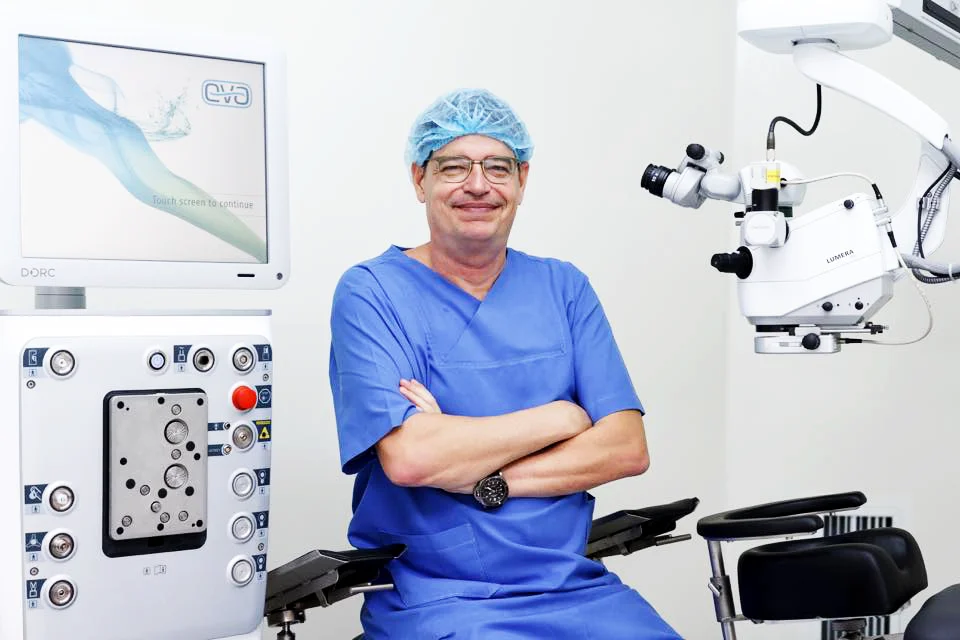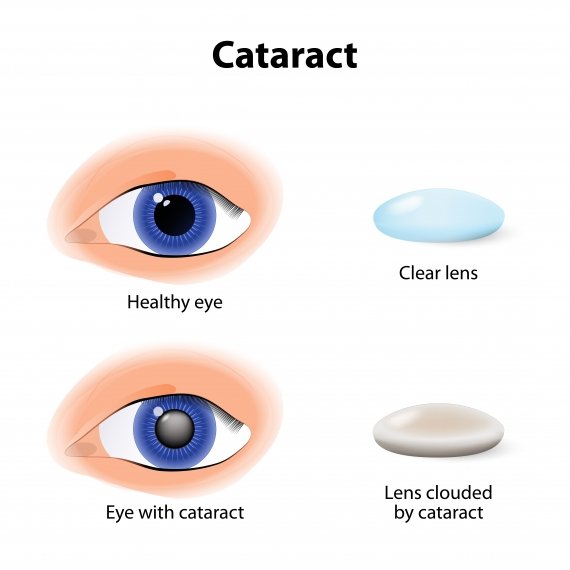Cataract removal surgery
What is cataract?
A cataract is a medical condition characterized by the clouding of the eye’s natural lens, which is usually clear. This clouding occurs due to the buildup of protein in the lens, leading to a gradual loss of transparency. As a result, vision becomes blurred, and individuals may experience difficulties with tasks such as reading, driving, or recognizing faces. Cataracts are primarily associated with aging, but other factors such as genetics, prolonged exposure to ultraviolet light, certain medications, and medical conditions like diabetes can contribute to their development.
Types of Cataracts
Cataracts can be classified into different types based on their location within the eye or the underlying cause. The main types of cataracts include:
Age-related cataracts
Age-related cataracts are a common type of cataracts that develop gradually with age. They are primarily associated with the natural aging process of the eye and result from the breakdown and clouding of the proteins in the lens. Age-related cataracts are one of the most prevalent forms of cataracts among older adults.
Nuclear Cataracts
These cataracts form in the center (nucleus) of the lens and are associated with aging. They cause a gradual yellowing or browning of the lens, resulting in vision impairment.
Cortical Cataracts
Cortical cataracts develop in the outer edges of the lens and progress inward. They appear as wedge-shaped opacities and can cause difficulties with contrast sensitivity and glare.
Subcapsular Cataracts
Subcapsular cataracts occur at the back of the lens, just beneath the lens capsule. They progress faster than other types and can cause significant vision disturbances, especially in bright light. Subcapsular cataracts are commonly seen in individuals with diabetes or those taking high doses of corticosteroids.
Congenital Cataracts
These cataracts are present at birth or develop during childhood. They can be caused by genetic factors, intrauterine infections, or metabolic disorders. Early detection and treatment are crucial for preventing visual impairment or developmental issues.
Traumatic Cataracts
Traumatic cataracts result from an eye injury, such as a blow to the eye. The impact can cause clouding or damage to the lens, leading to vision problems. Immediate medical attention is necessary in such cases.
.
Cataract treatment
Surgery is the only treatment for cataracts. Fortunately, it presents a secure and efficient solution for individuals afflicted by this condition. This surgical intervention entails the extraction of the clouded natural lens and replacing it with an artificial intraocular lens (IOL). Globally, cataract surgery stands as one of the most prevalent and successful procedures, witnessing millions of surgeries annually.
Phaco surgery for cataracts, or phacoemulsification, is one of the most popular cataract surgery in the world. It represents a pioneering progression in cataract care. This refined method utilizes ultrasonic vibrations to gently disintegrate and eliminate the hazy lens, minimizing eye trauma. Completed within approximately 15 to 30 minutes, this procedure features smaller incisions, ensuring a speedier recovery compared to conventional techniques. Administered under local anesthesia to prioritize patient comfort, Phaco eye surgery emerges as a meticulous and effective option for those aiming to reclaim sharp vision. This contemporary approach signifies a notable advancement in cataract surgery, offering patients a dependable and expeditious route to enhanced visual clarity.
Who may be in need of cataract surgery?
Cataract surgery is recommended for individuals experiencing vision impairment caused by the presence of cataracts. Common signs that may indicate the need for cataract surgery include blurred vision, difficulty seeing at night, impaired color perception, and a progressive decline in vision quality, even with corrective lenses. If cataracts interfere with daily activities such as reading, driving, or recognizing faces, surgery becomes a consideration. Additionally, frequent changes in eyeglasses or contact lens prescriptions due to cataracts may prompt the need for surgical intervention. The decision to undergo cataract surgery is made on an individual basis, taking into account the extent of visual impairment and its impact on the person’s overall quality of life. For those experiencing any of these symptoms, consulting with an eye care professional is crucial for a comprehensive examination and personalized guidance on the most suitable course of action.
Cataract removal operation
Cataract removal surgery is a seamless procedure that offers a renewed vision experience. During the approximately one-hour surgery, your eye doctor delicately removes the clouded lens and replaces it with an artificial lens known as an intraocular lens (IOL). Remarkably, the process is nearly painless, ensuring minimal discomfort for patients.
Throughout the surgery, you’ll remain awake, perceiving lights or motion without seeing the intricate details of the procedure. To ensure your comfort, your eye doctor may administer medication to keep you relaxed and calm during the surgery.
The surgical steps include:
- Application of numbing drops to prevent any sensation in your eye.
- Utilization of tiny tools to make precise incisions, break up the cloudy lens, and safely remove it.
- Implantation of the new artificial lens to restore clarity.
Following the placement of the new lens, a brief recovery period in an adjacent area ensures your well-being. The medical team will conduct checks to confirm the success of the procedure before you leave, providing assurance that your eye is on its way to optimal recovery.

Recovering from cataract surgery
After cataract surgery, a gentle recovery process unfolds, guiding you toward clearer vision. Emerging from the operating room, you’ll spend a brief period in a recovery area where medical professionals ensure your immediate well-being. Once home, the emphasis is on rest and relaxation, allowing your eyes to heal. Your doctor may prescribe special eye drops to prevent infection and inflammation, and protective eyewear may be provided for added caution. In the days following surgery, attend scheduled follow-up appointments, where your progress is monitored. While initial vision may be a touch blurry, patience reveals a gradual improvement over subsequent weeks. Sensitivity to light is normal, and sunglasses offer relief during outdoor activities. Avoiding eye rubbing or pressure is essential for proper healing. As you adhere to prescribed medications and gradually resume regular activities, the postoperative journey unfolds, bringing you closer to the full realization of your improved vision.
Types Of Cataract Lenses
Cataract surgery involves the removal of the clouded natural lens of the eye, which has become opaque due to cataract formation, and its replacement with an artificial intraocular lens (IOL). There are several types of intraocular lenses used in cataract surgery, each offering specific features and benefits. The choice of IOL depends on factors such as the patient’s visual needs, lifestyle, and overall eye health. Here are the main types of lenses used in cataract surgery:
Monofocal IOLs
Monofocal IOLs are the standard and most commonly used lenses in cataract surgery. They provide clear vision at a fixed distance, typically set for either distance vision (for driving and other distant activities) or near vision (for reading and close-up tasks). Patients may choose to have one eye corrected for distance and the other for near vision (monovision) to achieve a greater range of focus without glasses.
Multifocal IOLs
Multifocal IOLs are designed to provide multiple focal points, allowing patients to see clearly at various distances, including near, intermediate, and distance vision. These lenses reduce the need for reading glasses or bifocals, providing increased independence from corrective eyewear.
Accommodating IOLs
Accommodating IOLs are designed to mimic the eye’s natural focusing ability. They can move slightly within the eye in response to changes in the eye’s muscles, which helps patients achieve clear vision at different distances. While not as multifocal as dedicated multifocal IOLs, accommodating IOLs can provide a degree of spectacle independence.
Toric IOLs
Toric IOLs are specially designed to correct astigmatism, a common refractive error that causes blurred or distorted vision due to an irregularly shaped cornea. These lenses have additional power in specific meridians to correct the astigmatism, resulting in clearer vision without the need for glasses to correct the astigmatism.
It’s essential for patients to discuss their visual needs and preferences with their eye surgeon during the pre-operative consultation to determine the most suitable type of IOL for their individual cases. Each type of IOL has its advantages and limitations, and the right choice will depend on factors unique to each patient, ensuring they achieve the best possible visual outcome following cataract surgery.
Protecting Your Eyes from Cataracts
Several steps can be taken to reduce the risk of early cataracts or slow the progression of age-related cataracts:
- Shield your eyes from the sun by wearing sunglasses and a hat with a brim.
- Take precautions to avoid eye injuries by wearing protective eyewear during activities that pose a risk.
- Quit smoking.
- Make healthy dietary choices, focusing on fruits, vegetables, leafy greens, nuts, and whole grains.
- Regularly undergo comprehensive eye examinations to detect and address cataracts and other eye conditions at an early stage.
Cataract surgery cost in Vietnam
The cost of cataract surgery in Vietnam can vary depending on several factors, including the type of intraocular lens (IOL) used, the surgical facility, the surgeon’s experience, and the location within Vietnam. Generally, cataract surgery costs in Vietnam tend to be more affordable compared to many Western countries. However, specific pricing details may change over time, so it’s essential to contact local eye clinics or hospitals directly to get accurate and up-to-date information about the cost of cataract surgery in Vietnam. It’s also a good idea to inquire about any potential additional charges, post-operative care, and any available insurance coverage that might apply.
Experienced Cataract doctor
Our doctor, JD Ferwerda, is a long-stand experienced eye surgeon:
- Dr. JD obtained his Doctor of Medicine (M.D.) degree from the University of Utrecht in The Netherlands in 1993. In 2000, he became a Fellow in Vitreo-Retina Surgery and Diseases.
- With over 28 years of experience in treating patients prior to arriving in Vietnam, Dr. JD has successfully performed more than 10,000 cataract surgeries and 6,000 Retina surgeries.
- Dr. JD specializes in cataract and glaucoma surgeries, complex retina surgeries, and various other eye procedures, consistently utilizing the latest techniques and cutting-edge equipment.
If you require further information or have any inquiries, please do not hesitate to reach out to us. Our team is dedicated to guiding you on your journey towards clearer vision and an improved quality of life.


